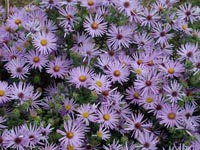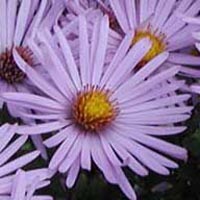Resource Library
Plant of the Week: Fragrant Aster
The University of Arkansas System Division of Agriculture does not promote, support or recommend plants featured in "Plant of the Week." Please consult your local Extension office for plants suitable for your region.
Plant of the Week
Fragrant Aster
Latin: aster oblogifolius

There is nothing subtle about the arrival of fall. You feel it in the air and each day seems shorter. Gardeners notice that fall flowering plants are finally getting a chance to shine. A plant that has caught my attention is one of these fall bloomers, Aster oblongifolius ‘Raydon’s Favorite’.
To most gardeners, asters are a bewildering. They look too much alike to see any easily discernable differences, but the botanists assure us they are different. Most of the asters grown in the garden are selections and hybrids of A. novae-angliae, the New England aster. It ranges widely from New England to New Mexico, but most of its natural range seems to be in the northeastern states. New England asters come in an assortment of colors with shades of blue-purple the most common but also whites, pinks and rose forms. My major disappointment with New England asters is that their flowers last such a short time - usually two to three weeks.
Aster oblongifolius, in reading the technical descriptions, is very much like the New England aster, but for a few minor differences. For one thing its range is different, occurring mostly in states of the Mississippi River watershed. Secondly, its foliage has a minty, aromatic aroma when crushed. Finally, New England asters bloom three to four weeks earlier than A. oblongifolius.
For an aster, Raydon’s Favorite is fairly tight and compact, growing about 18 inches tall the first year and then as much as doubling in height as the plant becomes established. Plants tend to be a little wider than tall. It has the typical inch and a half diameter, blue-purple aster flowers borne at the ends of the branches.

But, unlike the New England aster, once Raydon’s Favorite starts blooming, it keeps going until frost. The plants I watched last fall began blooming the last week of September and were clothed in flowers until frost stopped them during the first week of November. I’m not talking about a few scattered blossoms - it was covered in blooms and looked as good on Oct. 1 as Nov. 1. Like most asters, its flowers are a favorite of migrating monarchs.
The plant began appearing in the nursery trade about 1995, being introduced by Allen Bush, then with Holbrook Farm nursery. Bush received the plant from Raydon Alexander, a horticulturist in San Antonio, TX who apparently acquired it from the wild on Lookout Mountain in Tennessee.
Raydon’s Favorite is an easy to grow garden plant with excellent drought tolerance. It should be planted in full sun in an average garden soil. Fortunately though, it is also reported to tolerate clay soils without flinching. It drops its inner leaves in the hot, dry weather of summer, but seems no worse for the wear. If a more compact size is desired than its three foot height, whack it back in July and allow it to grow. Like most asters, division every three years or so should keep it vigorous and growing. No disease or insect problems have been noticed.
By: Gerald Klingaman, retired
Extension Horticulturist - Ornamentals
Extension News - September 19, 2003
The University of Arkansas System Division of Agriculture does not maintain lists of retail outlets where these plants can be purchased. Please check your local nursery or other retail outlets to ask about the availability of these plants for your growing area.